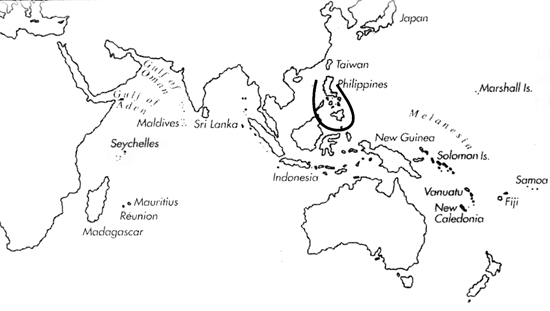Range: Philippines.
Description: Medium-sized to moderately large, moderately solid to solid. Last whorl narrowly conical or conical, outline convex at adapical fourth, straight below. Shoulder angulate. Spire usually of moderate height, outline concave. Larval shell of about 2.75 whorls, maximum diameter 0.7-0.8 mm. First 3-7 postnuclear whorls tuberculate. Teleoconch sutural ramps flat to concave, with 1 increasing to 3-4 spiral grooves. Last whorl with distinct to obsolete widely spaced spiral grooves on basal half.
| Shell Morphometry | ||
|---|---|---|
| L | 45-80 mm | |
| RW | 0.18-0.36 g/mm | |
| (L 45-73 mm) | ||
| RD | 0.46-0.55 | |
| PMD | 0.84-0.93 | |
| RSH | 0.11-0.21 | |
Ground colour white. Last whorl with a reticulate pattern of fine brown lines. Darker brown flecks concentrated in a spiral band on each side of centre, occasionally with underlying salmon bands. Base often tinged with salmon. In form colorovariegatus (Pl. 17, Figs. 17- l9), network pattern replaced by confluent brown blotches sometimes colouring last whorl solid brown. Larval whorls white. Teleoconch spire matching last whorl in colour pattern. Aperture white or pale pink.
Periostracum olive-grey, thin, translucent, smooth.
Habitat and Habits: In 120-240 m.
Discussion: C. neptunus is similar to C. lienardi and C. Iodostoma; for comparison, see the Discussions of those species. C. neptunoides, known only from the holotype (Pl. 17, Fig. 16) (RD 0.56; PMD 0.80; RSH 0.15), closely resembles C. neptunus and C. lienardi; we provisionally assign it to the former. Its provenance is uncertain.

C. neptunus range map
This section contains verbatim reproductions of the accounts of 316 species of Conus from the Indo-Pacific region, from Manual of the Living Conidae, by Röckel, Korn and Kohn (1995). They are reproduced with the kind permission of the present publisher, Conchbooks.
All plates and figures referred to in the text are also in Röckel, Korn & Kohn, 1995. Manual of the Living Conidae Vol. 1: Indo-Pacific Region.
The range maps have been modified so that each species account has it own map, rather than one map that showed the ranges of several species in the original work. This was necessary because each species account is on a separate page on the website and not confined to the order of accounts in the book.